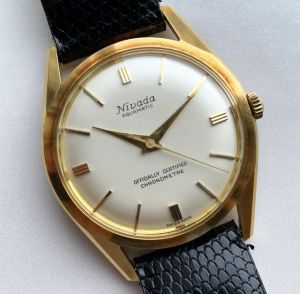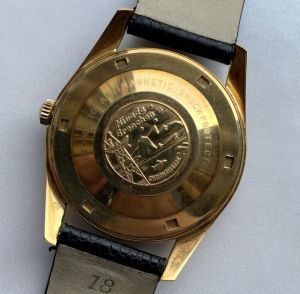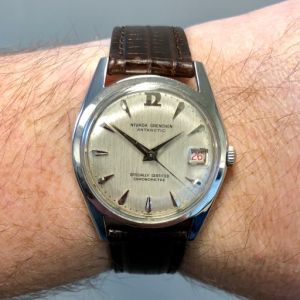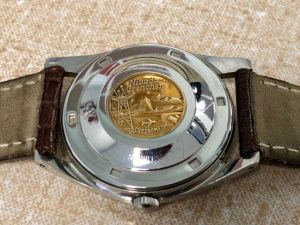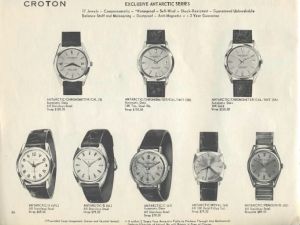Difference between revisions of "Nivada Antarctic Chronometre"
m |
|||
| Line 1: | Line 1: | ||
[[File:Nivada gold chrono 1.jpg|thumb|Nivada Antarctic Chronometre Gold]] | [[File:Nivada gold chrono 1.jpg|thumb|Nivada Antarctic Chronometre Gold]] | ||
==Nivada Antarctic Chronometre== | ==Nivada Antarctic Chronometre== | ||
| − | This particular model is part of Nivada’s Antarctic line, which reflects the brand’s support for the US Navy during “Operation Deep Freeze' for IGY in 1957/58 and was very much the top of the line watch for the company. It can be found in steel and (very rarely) solid 18k gold. Most notable is the case back with a beautiful gold medallion commemorating the expedition itself. The watch was issued circa 1957/8 and available for a few years, but based on observation, it is a rare thing indeed and very collectible now. | + | This particular model is part of Nivada’s Antarctic line, which reflects the brand’s support for the US Navy during “Operation Deep Freeze' for IGY in 1957/58 and was very much the top of the line watch for the company. It can be found in steel, gold plate and (very rarely) solid 18k gold. Most notable is the case back with a beautiful gold medallion commemorating the expedition itself. The watch was issued circa 1957/8 and available for a few years, but based on observation, it is a rare thing indeed and very collectible now. |
| − | Most versions seen are powered by the ETA 2472, an advanced movement in its day and quite similar to today’s 2824. Although just 18,000 A/h, it features bi-directional winding and “quickset” date (though not crown-set date like modern watches). It was tuned to chronometer specification at the factory, a prime selling point for this watch, similar to the [[Omega Constellation]]s of the same period. The dials are seen brushed, with the larger hour markers and dauphin hands seen on the other Antarctic models. | + | Most versions seen are powered by the ETA 2472, an advanced movement in its day and quite similar to today’s 2824. Although just 18,000 A/h, it features bi-directional winding and “quickset” date (though not crown-set date like modern watches). It was tuned to chronometer specification at the factory, a prime selling point for this watch, similar to the [[Omega Constellation]]s of the same period. The movements carry an engraved 4 digit number unique to each one and corresponding to the certificate accompanying the watch. |
| + | |||
| + | The dials are seen brushed, with the larger hour markers and dauphin hands seen on the other Antarctic models. Dials are seen with and without 12 at top. Steel versions also seen with gold markers and hands. Crown is unsigned. | ||
| Line 13: | Line 15: | ||
[[File:Novada medallion rear.jpg|thumb|Steel case with gold medallion]] | [[File:Novada medallion rear.jpg|thumb|Steel case with gold medallion]] | ||
| − | [[File:6F5086FB-1A1B-445F-AC98-1BE18CF000F0.jpeg|thumb| | + | [[File:6F5086FB-1A1B-445F-AC98-1BE18CF000F0.jpeg|thumb|Croton Catalogue 1960 - from IG @nivadamuseum ]] |
==Links== | ==Links== | ||
Revision as of 22:22, 25 March 2024
Nivada Antarctic Chronometre
This particular model is part of Nivada’s Antarctic line, which reflects the brand’s support for the US Navy during “Operation Deep Freeze' for IGY in 1957/58 and was very much the top of the line watch for the company. It can be found in steel, gold plate and (very rarely) solid 18k gold. Most notable is the case back with a beautiful gold medallion commemorating the expedition itself. The watch was issued circa 1957/8 and available for a few years, but based on observation, it is a rare thing indeed and very collectible now.
Most versions seen are powered by the ETA 2472, an advanced movement in its day and quite similar to today’s 2824. Although just 18,000 A/h, it features bi-directional winding and “quickset” date (though not crown-set date like modern watches). It was tuned to chronometer specification at the factory, a prime selling point for this watch, similar to the Omega Constellations of the same period. The movements carry an engraved 4 digit number unique to each one and corresponding to the certificate accompanying the watch.
The dials are seen brushed, with the larger hour markers and dauphin hands seen on the other Antarctic models. Dials are seen with and without 12 at top. Steel versions also seen with gold markers and hands. Crown is unsigned.
The gold one appear to be a no-date version which is perhaps more elegant and formal as befitting its 18k status, and with more simple dial and hand configuration. It is also a later model as indicated by the use of the Nivada logo-style script. What is slightly confusing is the use of Aquamatic rather than Antarctic on the dial!
Links
Credits and Further Reading -
